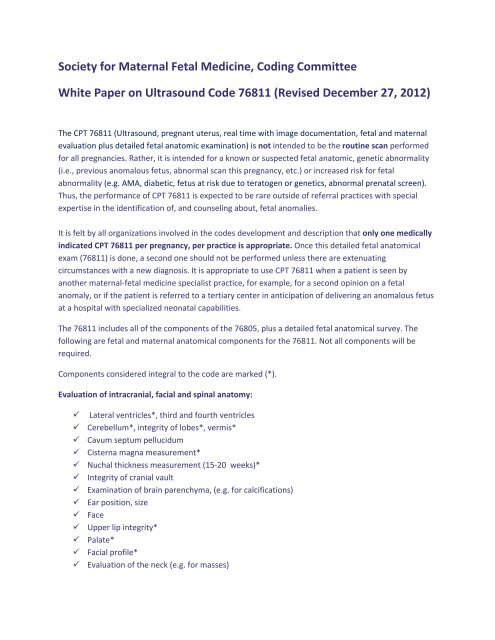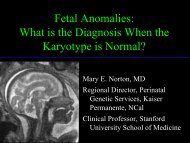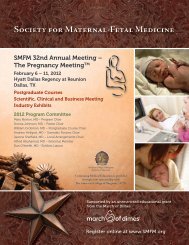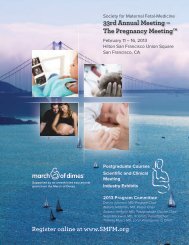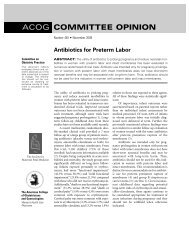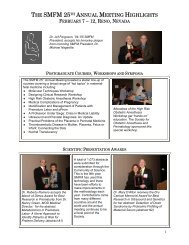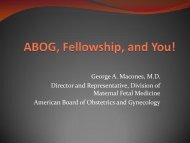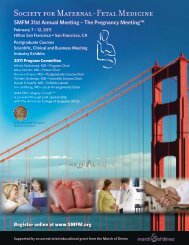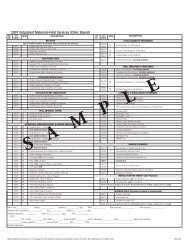Revised December 27 - Society for Maternal-Fetal Medicine
Revised December 27 - Society for Maternal-Fetal Medicine
Revised December 27 - Society for Maternal-Fetal Medicine
You also want an ePaper? Increase the reach of your titles
YUMPU automatically turns print PDFs into web optimized ePapers that Google loves.
<strong>Society</strong> <strong>for</strong> <strong>Maternal</strong> <strong>Fetal</strong> <strong>Medicine</strong>, Coding Committee<br />
White Paper on Ultrasound Code 76811 (<strong>Revised</strong> <strong>December</strong> <strong>27</strong>, 2012)<br />
The CPT 76811 (Ultrasound, pregnant uterus, real time with image documentation, fetal and maternal<br />
evaluation plus detailed fetal anatomic examination) is not intended to be the routine scan per<strong>for</strong>med<br />
<strong>for</strong> all pregnancies. Rather, it is intended <strong>for</strong> a known or suspected fetal anatomic, genetic abnormality<br />
(i.e., previous anomalous fetus, abnormal scan this pregnancy, etc.) or increased risk <strong>for</strong> fetal<br />
abnormality (e.g. AMA, diabetic, fetus at risk due to teratogen or genetics, abnormal prenatal screen).<br />
Thus, the per<strong>for</strong>mance of CPT 76811 is expected to be rare outside of referral practices with special<br />
expertise in the identification of, and counseling about, fetal anomalies.<br />
It is felt by all organizations involved in the codes development and description that only one medically<br />
indicated CPT 76811 per pregnancy, per practice is appropriate. Once this detailed fetal anatomical<br />
exam (76811) is done, a second one should not be per<strong>for</strong>med unless there are extenuating<br />
circumstances with a new diagnosis. It is appropriate to use CPT 76811 when a patient is seen by<br />
another maternal‐fetal medicine specialist practice, <strong>for</strong> example, <strong>for</strong> a second opinion on a fetal<br />
anomaly, or if the patient is referred to a tertiary center in anticipation of delivering an anomalous fetus<br />
at a hospital with specialized neonatal capabilities.<br />
The 76811 includes all of the components of the 76805, plus a detailed fetal anatomical survey. The<br />
following are fetal and maternal anatomical components <strong>for</strong> the 76811. Not all components will be<br />
required.<br />
Components considered integral to the code are marked (*).<br />
Evaluation of intracranial, facial and spinal anatomy:<br />
Lateral ventricles*, third and fourth ventricles<br />
Cerebellum*, integrity of lobes*, vermis*<br />
Cavum septum pellucidum<br />
Cisterna magna measurement*<br />
Nuchal thickness measurement (15‐20 weeks)*<br />
Integrity of cranial vault<br />
Examination of brain parenchyma, (e.g. <strong>for</strong> calcifications)<br />
Ear position, size<br />
Face<br />
Upper lip integrity*<br />
Palate*<br />
Facial profile*<br />
Evaluation of the neck (e.g. <strong>for</strong> masses)
Evaluation of the chest:<br />
Presence of masses*<br />
Pleural effusion*<br />
Integrity of both sides of the diaphragm*<br />
Appearance of ribs<br />
Evaluation of the heart:<br />
Cardiac location and axis*<br />
Outflow tracts*<br />
Evaluation of the abdomen:<br />
Bowel *<br />
Adrenal glands<br />
Gallbladder<br />
Liver<br />
Spleen<br />
Ascites*<br />
Masses<br />
Evaluation of genitalia:<br />
Gender (whether or not parents wish to know sex of child)<br />
Evaluation of limbs:<br />
Number, size, and architecture*<br />
Anatomy and position of hands*<br />
Anatomy and position of feet*<br />
Evaluation of the placenta and cord:<br />
Placental cord insertion site*<br />
Placental masses*<br />
Umbilical‐cord (number of arteries)<br />
Evaluation of amniotic fluid:<br />
Assessment of Amniotic Fluid Volume*<br />
Evaluation of the cervix (Not required)<br />
Evaluation of the maternal adnexa when feasible*
Note: If any of the required fetal or maternal components are non‐visualized due to fetal position, late<br />
gestational age, maternal habitus, etc., it must be clearly noted in the ultrasound report in order to<br />
meet the requirements to bill <strong>for</strong> the service.<br />
Follow‐up ultrasound per<strong>for</strong>med after a Detailed Ultrasound (CPT 76811), should be reported as CPT<br />
76816 (Ultrasound, pregnant uterus, real time with image documentation, follow‐up). This includes<br />
per<strong>for</strong>ming a focused assessment of fetal size by measuring the BPD, abdominal circumference, femur<br />
length, or other appropriate measurements, OR a detailed re‐examination of a specific organ or system<br />
known or suspected to be abnormal.<br />
CPT 76805 (Ultrasound, pregnant uterus, real time with image documentation, fetal and maternal<br />
evaluation, after first trimester (> or = 14 weeks 0 days), would be reported to determine the number of<br />
fetuses, amniotic/chorionic sacs, survey of intracranial, spinal, and abdominal anatomy, evaluation of a<br />
4‐chamber heart view, assessment of the umbilical cord insertion site, assessment of amniotic fluid<br />
volume, and evaluation of maternal adnexa when visible when appropriate.<br />
When per<strong>for</strong>ming a routine screening ultrasound, (no maternal or fetal indications or abnormal<br />
findings), you would be reporting CPT Code 76805 and V28.3.<br />
We hope this clears up any confusion regarding the use of the detailed fetal anatomical exam (76811).


